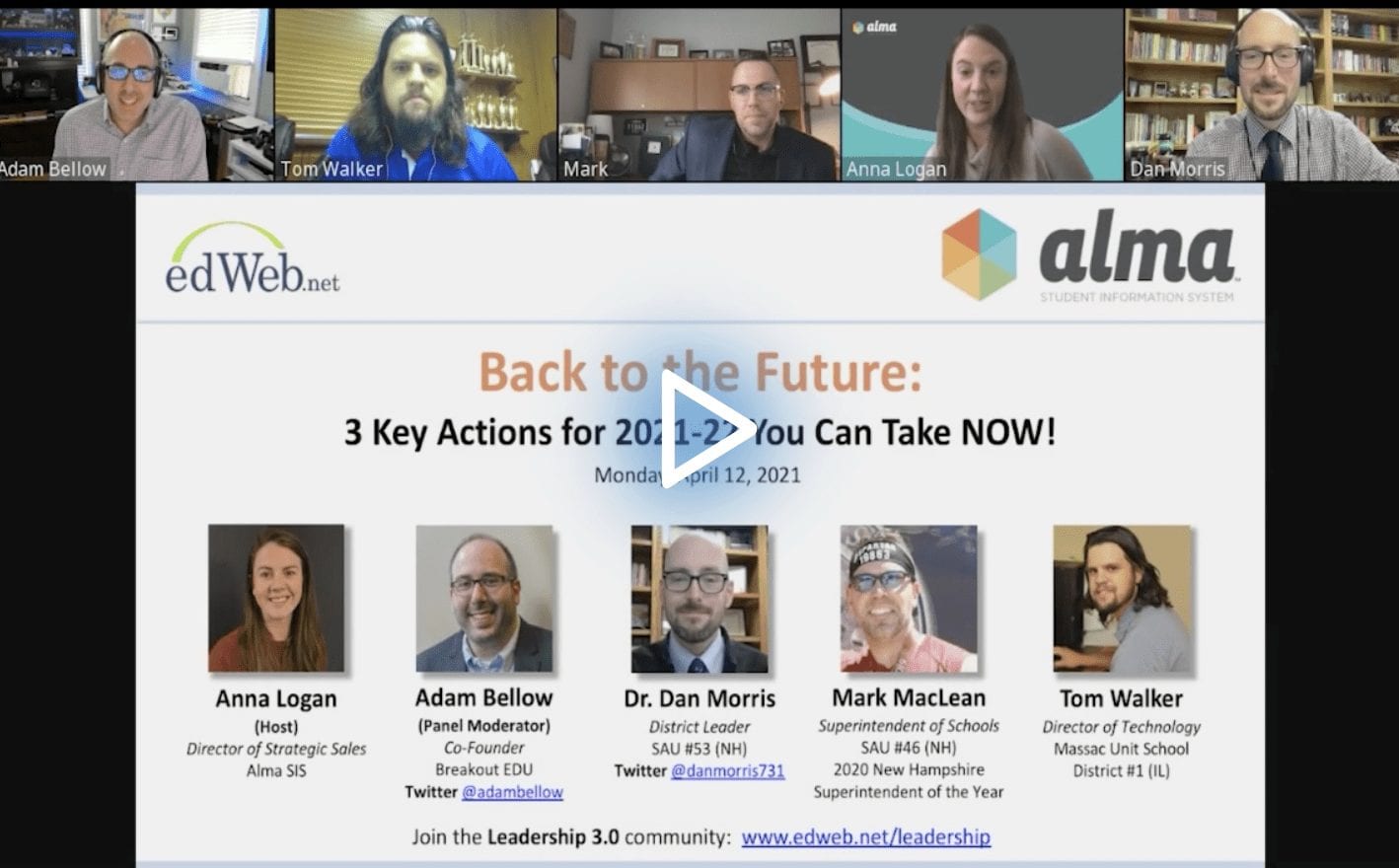3 Key Actions for 2021-22 You Can Take Now
By Michele Israel
WATCH THE EDLEADER PANEL RECORDING
What’s that they say about a silver lining? It looks like COVID-19 has one in the education sphere. Despite myriad challenges schools faced during the pandemic, many will come out of it with richer approaches to teaching and learning.
In the edLeader Panel, “Back to the Future: 3 Key Actions for 2021-22 You Can Take NOW,” sponsored by Alma SIS, educational leaders described projects they plan to pursue post-COVID to maximize newly available federal funds, foster equity and inclusion, and “future proof” their learning communities.
Action 1: Spend Money on Long-Term Initiatives
COVID’s impact on schools was so substantial that Congress established the Elementary and Secondary School Emergency Relief Fund (ESSER). Schools and districts can use these funds to address critical areas of need.
Much of the first round of funding went to related single-serving interventions, such as buying items safety measures and 1:1 tech devices.
“In ESSER I,” said Mark MacLean, Superintendent of Schools for SAU #46 in New Hampshire, “we were in a reactionary mindset. We were looking at PPE, at reimbursements, at everything we needed to respond to the pandemic.”
ESSER II has encouraged educational leaders to creatively and strategically design programs to support school communities over the long term. They are pursuing practical and innovative initiatives. The project possibility is wide ranging, thanks to the funding’s flexibility. Initiatives include:
- Building an outdoor restroom to provide expanded outdoor learning.
- Upgrading HVAC systems and roofs and windows.
- Reinventing spaces—designing flexible classroom spaces and turning a library into a learning commons with flexible seating and mobile bookshelves.
- Establishing summer academies to address unfinished learning and learners’ social-emotional status.
Enhanced ways of responding to student progress and engaging them in standards-based learning are also on the funding plan. MacLean’s district shed some traditional grading schema to address learning during COVID and is exploring how to continue providing alternate ways to assess learners. It is looking to link students with hybrid, remote, and “fully all-in” learning and ways to teach with and connect skills across these modalities.
The panelists are relying more on platforms like Alma SIS to provide consistent reporting methods, improved linkages to student information and data-oriented approaches to address unfinished learning and struggling students.
“I think of the pandemic as kind of a great disrupter for many things,” reflected Dr. Dan Morris, District Leader for SAU #53 in New Hampshire. “That also includes our curriculum and our instructional delivery. So you know, we can use this as an opportunity to audit how we provide students with content and how we ask students to learn that.”
“Never waste a crisis; see it as a way to move forward,” he said.
Action 2: Pursue Equity and Inclusion
During the pandemic, existing inequities in schools became more apparent. They showed up in tech access and connectivity, food availability and even transportation, especially in historically underserved communities. Students and families struggled.
Schools and districts set up temporary solutions that got them through the most challenging pandemic moments, from tech access to transportation. Still, the panelists emphasized that schools and districts need to get beyond the band-aids to address the equity gaps.
Tech access and connectivity topped the list of equity issues, especially in communities already lacking in critical services. The panelists put stopgaps in place to ensure students were learning and engaged: providing devices such as Chromebooks to all students and setting up WiFi hotspots.
Yet, even with devices and access, students who were already struggling academically pre-pandemic had an even harder time learning at home. Engagement gaps were more pronounced. Schools and districts will need to look hard at those gaps to ensure equitable engagement across learning modalities.
Socio-economic disparities grew during the crisis. Access to food, for example, among them. “During the spring of 2020,” shared Tom Walker, Director of Technology for Massac Unit School District #1 in Illinois, “our focus was, because of all the inequity, making sure first and foremost that our students were fed.” The district used Alma to target addresses, put them in Google My Maps to find out where students were located, and set up about 20 satellite meal locations.
Family engagement also declined, in part because of communication inequities. It became more difficult to reach parents by email; thus, they did not know how their students were faring in school or what they needed. Systems like Alma helped as communication tools and as a retainer of critical student information that educators shared with parents once they could be reached.
Students learning at home who needed social supports also struggled. School for them has traditionally been a social institution. While some supports were available virtually, they were not always sufficient enough to undergird student needs.
The panelists emphasized that such situations deepened awareness of equity gaps they plan to tackle post-COVID.
Action 3: Future Proof Your School
What else must educational leaders do to get their schools and districts future ready? Build on what worked, address challenges that emerged, and improve where possible.
MacLean, Morris and Walker emphasized that everything they learned and applied will figure into their long-term planning. Many COVID-centered solutions will expand and new approaches to teaching and learning will be implemented. Here are just a few of the many things they are prepared to put in place moving forward:
- Set up more WiFi hotspots and provide additional devices to students.
- Use Alma for course registration.
- Cultivate a mindset on using new tech apps, invaluable during the pandemic: Google Classroom, Google Drive, Kahoot!, EdPuzzle, Lucidchart, and Plickers, all among the various tools schools used to support teaching and learning.
- Grow educators’ level of courage to bridge the technology gap.
- Enhance family communication and engagement using tools like Smore, Alma, Remind, Google Meet, and Class Dojo and even create videos to engage with parents and give students tours of the school.
- Establish agreements with tech vendors and use tools like Securly to ensure student privacy.
And most important, enhance community and school spirit, no matter the learning environment.
The future is looking better in schools and districts. It’s hard to believe after a year of turmoil. Morris best sums up what comes from COVID, as difficult as it was. “It’s an opportunity. Never waste a crisis. Take it as a good way to move forward.”
This edWeb broadcast was sponsored by Alma SIS.
WATCH THE EDLEADER PANEL RECORDING
About the Presenters
Adam Bellow
Adam Bellow is a dedicated educational technologist, father of two young boys, and co-founder of Breakout EDU, the immersive gaming platform that enables teachers and students to transform classrooms into places of discovery and inquiry-based learning. Previously, he served as a Presidential Innovation Fellow for the White House, and created several edtech learning platforms including eduTecher and eduClipper. Adam has written numerous books about educational technology and speaks internationally on the subject of education and technology. Adam also sits on the advisory board of Alma SIS.
Dr. Dan Morris
Dr. Dan Morris is the proud headmaster of Pembroke Academy, a 200-year-old regional public high school in central New Hampshire. He has an Ed.D. from Plymouth State University and his professional interests include competency-based education, systems thinking, and collaborative leadership. Follow him on Twitter @danmorris731.
With nearly three decades of experience in public education, Mark MacLean has been a classroom teacher, a department chair, a building-level administrator, an assistant superintendent, and a superintendent. In every role, technology, innovation, and a future focus have been integral. As a classroom teacher, Mark was recognized as New Hampshire’s Technology Using Educator of the Year in 2003. In 2020, he was honored as the New Hampshire Superintendent of the Year. A former computer graphics, programming, accounting, and entrepreneurship instructor, Mark thrives in both creative and analytical environments. Always seeking creative and applicable technological innovations and efficiencies, Mark embraces change and is confident in leading others through the process. Mark is a doctoral candidate at Plymouth State University, serves on the New Hampshire School Administrators Association (NHSAA) Executive Board, and is one of two New Hampshire representatives on the American Association of School Administrators (AASA) Governing Board.
Tom Walker is currently the director of technology for Massac Unit School District #1 in Metropolis, Illinois. He has been in education for over 14 years as a mathematics teacher, technology coordinator, principal, and college instructor. He is also a member of the Securly Educational Advisory Council. From Chromebooks in 2012, Securly in 2013, and with Massac as one of the first school districts to deploy Alma in Illinois, Tom thoroughly enjoys early-adoption projects.
Anna Logan is Alma’s Director of Strategic Sales. Anna has guided hundreds of educators and their districts through transitioning from legacy SIS to upgraded, future-proof SIS systems since 2012.
Join the Community
Leadership 3.0 is a free professional learning community on edWeb.net where school and district leaders collaborate on innovative strategies to help teachers grow professionally, advance student learning, and improve communications with all stakeholders.
Alma builds critical SIS tooling that significantly improves school operations and empowers educators to foster better student outcomes, so we can create the greatest generation of educators, so that they can create the greatest generation of students.
Michele Israel writes about the ideas and best practices that are shared in edWeb’s edWebinars so they can spread innovative and best practices to the education community. Michele owns Michele Israel Consulting, LLC, which serves large and small educational, non-profit, media, corporate, eLearning, and blended learning organizations to bolster products and programs. Her rich career spans over 25 years of successfully developing educational materials and resources, designing and facilitating training, generating communication materials and grant proposals, and assisting in organizational and program development. In addition to lesson plans and other teacher resources, Michele’s portfolio includes published articles covering a range of educational and business topics.





Comments are closed.